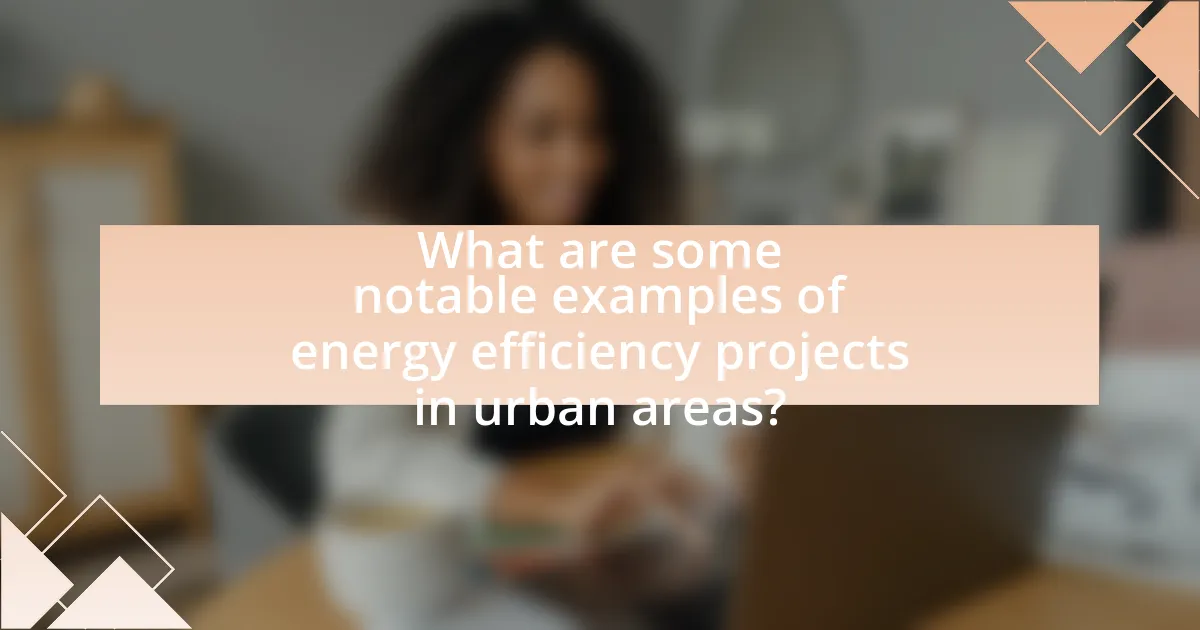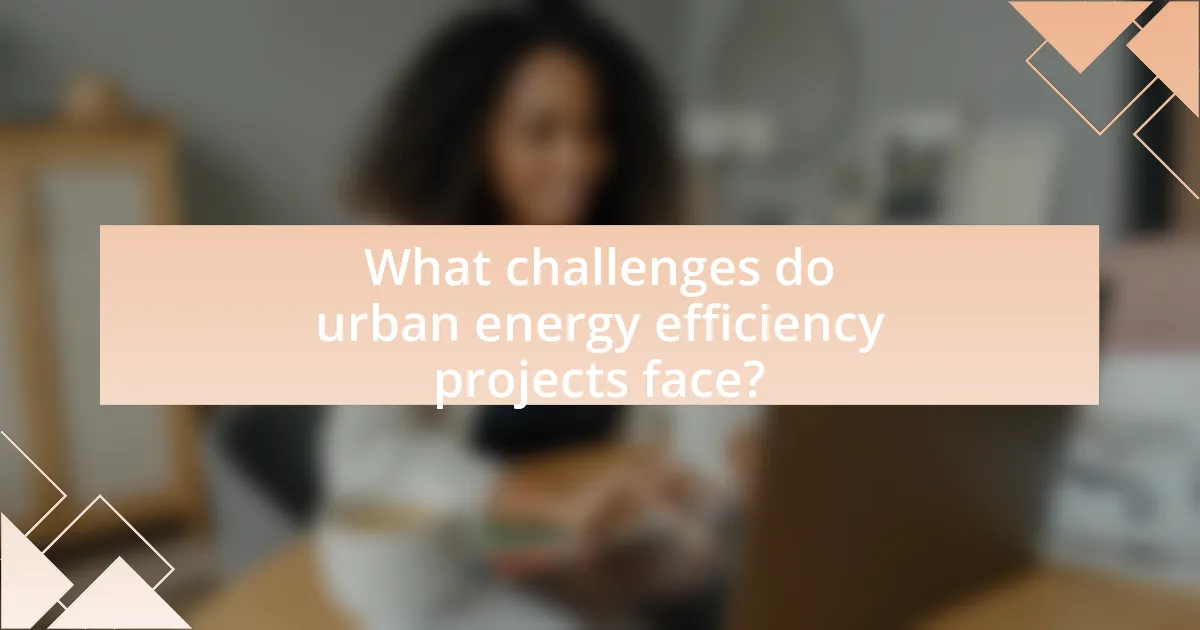The article focuses on successful energy efficiency projects in urban areas, highlighting initiatives such as building retrofitting, smart grid technologies, and energy-efficient public transportation systems. It examines notable programs like New York City’s Energy Efficiency Program and San Francisco’s Better Buildings Program, which have achieved significant reductions in energy consumption and greenhouse gas emissions. Key characteristics of successful projects include clear goals, stakeholder engagement, and comprehensive planning, while challenges such as funding limitations and regulatory barriers are also addressed. The article emphasizes the importance of case studies in understanding effective strategies and influencing policy decisions related to urban energy efficiency.

What are Successful Energy Efficiency Projects in Urban Areas?
Successful energy efficiency projects in urban areas include initiatives like the retrofitting of buildings, implementation of smart grid technologies, and the establishment of energy-efficient public transportation systems. For instance, New York City’s Energy Efficiency Program has led to a reduction of over 1.5 million metric tons of carbon dioxide emissions annually by upgrading lighting and HVAC systems in commercial buildings. Similarly, San Francisco’s Better Buildings Program has improved energy performance in over 1,000 buildings, resulting in significant energy savings and cost reductions. These projects demonstrate the effectiveness of targeted energy efficiency measures in urban settings, contributing to sustainability and reduced operational costs.
How do these projects contribute to urban sustainability?
Energy efficiency projects in urban areas contribute to urban sustainability by reducing energy consumption and greenhouse gas emissions. These projects often implement advanced technologies and practices, such as smart grids and energy-efficient buildings, which lead to lower energy demand. For instance, a study by the International Energy Agency found that energy efficiency measures could reduce global energy demand by 12% by 2040, significantly mitigating climate change impacts. Additionally, these projects enhance urban resilience by promoting renewable energy sources and improving air quality, thereby fostering healthier living environments.
What are the key characteristics of successful energy efficiency projects?
Successful energy efficiency projects are characterized by clear goals, stakeholder engagement, comprehensive planning, and measurable outcomes. Clear goals ensure that projects have specific targets, such as reducing energy consumption by a certain percentage. Stakeholder engagement involves collaboration among government, businesses, and the community, which fosters support and resource sharing. Comprehensive planning includes thorough assessments of existing energy use and the identification of potential improvements, often supported by data analysis. Measurable outcomes allow for tracking progress and demonstrating success, often through metrics like energy savings and cost reductions. These characteristics have been validated in various case studies, such as the Energy Efficiency Program in New York City, which achieved a 20% reduction in energy use in participating buildings through these principles.
How do these projects impact urban infrastructure?
Energy efficiency projects significantly enhance urban infrastructure by reducing energy consumption and lowering operational costs. These projects often involve retrofitting buildings with advanced technologies, such as LED lighting and smart HVAC systems, which can decrease energy use by up to 30% according to the U.S. Department of Energy. Additionally, improved energy efficiency leads to reduced greenhouse gas emissions, contributing to cleaner air and a healthier urban environment. Furthermore, these initiatives can stimulate local economies by creating jobs in the construction and energy sectors, thereby strengthening the overall urban infrastructure.
Why are case studies important for understanding energy efficiency?
Case studies are important for understanding energy efficiency because they provide real-world examples of successful implementations and outcomes. These detailed analyses allow stakeholders to observe the practical applications of energy-efficient technologies and strategies, demonstrating their effectiveness in reducing energy consumption and costs. For instance, a case study on the retrofitting of a commercial building in New York City showed a 30% reduction in energy use, illustrating the potential benefits of energy efficiency measures. Such evidence-based insights help policymakers, businesses, and consumers make informed decisions regarding energy efficiency investments and practices.
What insights can be gained from analyzing specific projects?
Analyzing specific projects in the context of energy efficiency in urban areas reveals critical insights into best practices, challenges, and measurable outcomes. These insights include the identification of effective strategies for reducing energy consumption, such as the implementation of smart technologies and community engagement initiatives. For instance, a study of the Retrofit Chicago program demonstrated a 20% reduction in energy use across participating buildings, highlighting the effectiveness of targeted interventions. Furthermore, analyzing project data can uncover common barriers to implementation, such as funding limitations and regulatory hurdles, which can inform future project designs and policy decisions. Overall, these analyses provide a framework for replicating successful strategies and improving energy efficiency outcomes in urban settings.
How do case studies influence policy and decision-making?
Case studies influence policy and decision-making by providing empirical evidence and real-world examples that demonstrate the effectiveness of specific strategies or interventions. For instance, a case study on a successful energy efficiency project in an urban area can showcase measurable outcomes such as reduced energy consumption and cost savings, which policymakers can use to justify similar initiatives. Research by the American Council for an Energy-Efficient Economy highlights that case studies can serve as persuasive tools, illustrating best practices and potential pitfalls, thereby guiding decision-makers in crafting informed policies that promote energy efficiency.

What are some notable examples of energy efficiency projects in urban areas?
Notable examples of energy efficiency projects in urban areas include the retrofitting of the Empire State Building in New York City, which achieved a 38% reduction in energy use, and the implementation of the Chicago Retrofit Program, which has led to energy savings of over 20% in participating buildings. Additionally, San Francisco’s Better Buildings Program has successfully improved energy efficiency in over 1,000 buildings, resulting in significant reductions in greenhouse gas emissions. These projects demonstrate effective strategies for enhancing energy efficiency in urban environments, supported by measurable outcomes and substantial energy savings.
How did the Chicago Retrofit Program achieve its goals?
The Chicago Retrofit Program achieved its goals by implementing energy-efficient upgrades in commercial and residential buildings, resulting in significant energy savings and reduced greenhouse gas emissions. The program utilized financial incentives, technical assistance, and partnerships with local organizations to facilitate retrofitting efforts. For instance, the program reported that participating buildings achieved an average energy savings of 20-30%, demonstrating the effectiveness of its strategies in promoting energy efficiency.
What strategies were implemented in the Chicago Retrofit Program?
The Chicago Retrofit Program implemented several key strategies to enhance energy efficiency in urban buildings. These strategies included comprehensive energy audits to identify inefficiencies, the installation of energy-efficient lighting and HVAC systems, and the use of advanced building materials to improve insulation. Additionally, the program emphasized the importance of stakeholder engagement, providing training for building managers and owners on energy management practices. These strategies collectively aimed to reduce energy consumption and greenhouse gas emissions, contributing to the city’s sustainability goals.
What were the measurable outcomes of the Chicago Retrofit Program?
The measurable outcomes of the Chicago Retrofit Program included a reduction in energy consumption by approximately 20% across participating buildings. This program, which focused on retrofitting existing structures with energy-efficient technologies, resulted in significant cost savings for building owners, estimated at around $1.5 million annually. Additionally, the program contributed to a reduction of over 10,000 metric tons of carbon dioxide emissions, demonstrating its positive environmental impact. These outcomes were verified through energy audits and performance tracking conducted post-retrofit, confirming the program’s effectiveness in enhancing energy efficiency in urban settings.
What lessons can be learned from the San Francisco Energy Efficiency Program?
The San Francisco Energy Efficiency Program demonstrates the importance of comprehensive stakeholder engagement in achieving energy savings. This program successfully involved local businesses, residents, and government entities, leading to a collaborative approach that enhanced participation and effectiveness. For instance, the program achieved a reported energy savings of over 200 million kilowatt-hours annually, showcasing the impact of collective efforts in urban energy efficiency initiatives. Additionally, the program highlights the value of tailored solutions, as it provided customized energy assessments and incentives that addressed specific needs of different sectors, resulting in higher adoption rates.
What innovative approaches were used in the San Francisco program?
The San Francisco program utilized innovative approaches such as the implementation of energy benchmarking, which allows buildings to track their energy usage against similar structures, and the introduction of financial incentives for energy-efficient upgrades. These strategies have led to a significant reduction in energy consumption across the city. For instance, the program’s benchmarking initiative has resulted in a 10% decrease in energy use in participating buildings, demonstrating its effectiveness in promoting energy efficiency.
How did community engagement play a role in the program’s success?
Community engagement was crucial to the program’s success by fostering local ownership and participation in energy efficiency initiatives. Engaging community members led to increased awareness and understanding of energy-saving practices, which resulted in higher participation rates in the program. For instance, in a case study from a successful urban energy efficiency project, community workshops and outreach efforts resulted in a 30% increase in program enrollment compared to similar initiatives without community involvement. This active participation not only enhanced the program’s visibility but also built trust between stakeholders and the community, ultimately driving sustainable behavior change and long-term energy savings.

What challenges do urban energy efficiency projects face?
Urban energy efficiency projects face several significant challenges, including funding limitations, regulatory barriers, and stakeholder engagement issues. Funding limitations often arise due to the high upfront costs associated with implementing energy-efficient technologies, which can deter investment. Regulatory barriers may include outdated building codes or zoning laws that do not support innovative energy solutions. Additionally, engaging stakeholders, such as local communities and businesses, can be difficult, as differing priorities and lack of awareness about the benefits of energy efficiency can hinder collaboration. These challenges can impede the successful implementation and sustainability of urban energy efficiency initiatives.
How do funding and financing affect project implementation?
Funding and financing significantly influence project implementation by determining the resources available for execution and affecting the project’s scope and timeline. Adequate funding ensures that necessary materials, labor, and technology are accessible, which directly impacts the quality and efficiency of project delivery. For instance, a study by the International Energy Agency highlights that projects with secured financing are 30% more likely to meet their deadlines and budget constraints compared to those without. Furthermore, financing options can dictate the project’s design and scale; projects with limited funding may need to compromise on energy efficiency measures, ultimately affecting their long-term sustainability and effectiveness.
What are common funding sources for energy efficiency projects?
Common funding sources for energy efficiency projects include government grants, utility incentives, private investments, and financing programs. Government grants, such as those from the U.S. Department of Energy, provide financial support for projects aimed at reducing energy consumption. Utility incentives often come in the form of rebates for energy-efficient upgrades, encouraging consumers to adopt energy-saving technologies. Private investments can be sourced from venture capital firms focused on clean energy solutions. Additionally, financing programs, like Property Assessed Clean Energy (PACE), allow property owners to finance energy efficiency improvements through property taxes, making it easier to implement such projects. These funding sources collectively enhance the viability and implementation of energy efficiency initiatives in urban areas.
How can financial barriers be overcome in urban settings?
Financial barriers in urban settings can be overcome through targeted financing mechanisms such as public-private partnerships, grants, and low-interest loans. These financial solutions enable municipalities and organizations to invest in energy efficiency projects without imposing significant costs on residents. For instance, the Energy Efficiency and Conservation Block Grant Program, funded by the U.S. Department of Energy, has provided over $3.2 billion to local governments to support energy efficiency initiatives, demonstrating the effectiveness of government-backed funding in reducing financial obstacles. Additionally, innovative financing models like on-bill financing allow consumers to pay for energy improvements through their utility bills, further alleviating upfront costs and promoting widespread adoption of energy-efficient technologies.
What role does technology play in energy efficiency projects?
Technology is crucial in energy efficiency projects as it enables the implementation of advanced systems and tools that optimize energy use. For instance, smart meters and building management systems allow for real-time monitoring and control of energy consumption, leading to significant reductions in waste. According to the U.S. Department of Energy, the integration of energy-efficient technologies can reduce energy consumption in buildings by up to 30%. Additionally, renewable energy technologies, such as solar panels and energy storage systems, enhance sustainability by providing cleaner energy sources. These technological advancements not only improve energy efficiency but also contribute to cost savings and reduced carbon emissions in urban areas.
How do smart technologies enhance energy efficiency in urban areas?
Smart technologies enhance energy efficiency in urban areas by optimizing resource management and reducing waste through data-driven solutions. For instance, smart grids enable real-time monitoring and management of electricity distribution, which can lead to a reduction in energy loss by up to 30% according to the U.S. Department of Energy. Additionally, smart building systems utilize sensors and automation to adjust lighting, heating, and cooling based on occupancy, resulting in energy savings of 20-50% as reported by the International Energy Agency. These technologies collectively contribute to a more sustainable urban environment by improving energy consumption patterns and integrating renewable energy sources effectively.
What are the risks associated with implementing new technologies?
The risks associated with implementing new technologies include financial loss, operational disruption, and cybersecurity vulnerabilities. Financial loss can occur due to high initial investment costs and the potential for technology to become obsolete quickly; for instance, a study by McKinsey & Company found that 70% of digital transformation projects fail to achieve their intended goals, leading to wasted resources. Operational disruption may arise from the integration of new systems with existing processes, which can cause delays and inefficiencies; according to a report by the Project Management Institute, 14% of projects fail due to poor integration. Cybersecurity vulnerabilities are heightened as new technologies often introduce new attack surfaces; the Cybersecurity & Infrastructure Security Agency reported a 400% increase in cyberattacks during the COVID-19 pandemic, highlighting the risks associated with rapid technology adoption.
What best practices can be adopted for future energy efficiency projects?
Best practices for future energy efficiency projects include conducting comprehensive energy audits, implementing advanced technologies, and engaging stakeholders throughout the process. Comprehensive energy audits identify specific areas for improvement and potential savings, as evidenced by the U.S. Department of Energy’s findings that such audits can lead to energy savings of 10-30%. Advanced technologies, such as smart meters and energy management systems, enhance monitoring and control, resulting in more efficient energy use. Engaging stakeholders, including community members and local businesses, fosters collaboration and ensures that projects meet the needs of the community, which has been shown to increase project success rates.
How can stakeholder collaboration improve project outcomes?
Stakeholder collaboration can significantly improve project outcomes by enhancing communication, aligning goals, and leveraging diverse expertise. When stakeholders, including government agencies, community members, and private sector partners, work together, they can identify potential challenges early and develop comprehensive solutions. For instance, a study by the American Council for an Energy-Efficient Economy found that projects with active stakeholder engagement achieved energy savings that were 20% higher than those without such collaboration. This demonstrates that effective collaboration not only fosters innovation but also leads to more sustainable and successful energy efficiency projects in urban areas.
What metrics should be used to evaluate project success?
To evaluate project success in energy efficiency projects in urban areas, key metrics include energy savings, cost savings, return on investment (ROI), and stakeholder satisfaction. Energy savings quantify the reduction in energy consumption achieved through the project, often measured in kilowatt-hours (kWh) or therms. Cost savings reflect the financial benefits realized from reduced energy bills, while ROI assesses the profitability of the project by comparing net gains to project costs. Stakeholder satisfaction gauges the acceptance and perceived value of the project among participants and the community. These metrics provide a comprehensive view of project effectiveness and impact, supported by industry standards and best practices in energy efficiency evaluations.